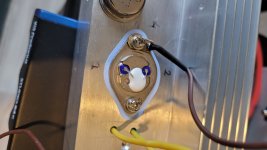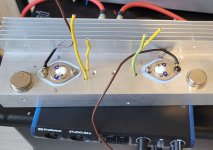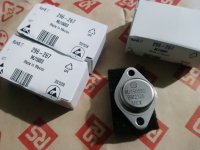Very fake. The tops don’t come off that easy on real ones. If it said “ON” and the markings rub off that’s another red flag.
I contacted the place I bought it from and returned it. I think it's fake too. They increased the amperage resistance by connecting 3 different small transistors to each other.
I can’t see what’s under the goop. I’ve seen two dies before, haven’t seen three. That would be a first. There are a handful of types out there that are supposed to have two dies, but MJ15003, MJ15024, and 2SC3281 aren’t among them and I’ve seen two die fakes of all three. MJ15024 has two bond wires on the emitter, but it’s one big die.
Some real makers (Non-ON) use the white or clear goop, but the tops still take an act of Congress to remove.
Some real makers (Non-ON) use the white or clear goop, but the tops still take an act of Congress to remove.
The blob of white goo on the die is also a dead giveaway... I have some good parts I scored from one of Papa's early giveaways at Burning Amp.
I always wonder which ink they use on the originals? Very hard to remove.
The goop is a dead giveaway if it said “ON” on the package. Many older Jap parts and some new Taiwan sources have the goop in their TO-3’s. But the top hats are just as hard - if not harder - to get off in one piece as real Motorola/ON. Ever tried getting one off an old Sanken? Takes a pound of C4 or a miracle from God. And real epoxy packaged parts, regardless of who made them, never used the goop.
I was going to use it in the production of jlh69, but it turned out to be fake and my work will take another 20 days. Damn these counterfeiters.

The market is getting very bad for fakes. I bought some NE5532 op amps from a local formerly respectable old school supplier and found out they were fake, so advised them. This supplier is one of the two go-to suppliers for the Australian magazine, Silicon Chip, when they publish projects.
After initial denials and then some months apparently checking with their supplier (the identity of whom was not disclosed) they admitted they were fake and merely offered replacements - they didn't try to explain, were not embarrassed, and did not apologise to me. I thought this was poor form - I'd have been mortified if it was my business!
I didn't bother with replacements as I didn't trust they'd be genuine either. I won't buy silicon from them again.
After initial denials and then some months apparently checking with their supplier (the identity of whom was not disclosed) they admitted they were fake and merely offered replacements - they didn't try to explain, were not embarrassed, and did not apologise to me. I thought this was poor form - I'd have been mortified if it was my business!
I didn't bother with replacements as I didn't trust they'd be genuine either. I won't buy silicon from them again.
I experienced the same thing you experienced. Old suppliers are no longer reliable. You have to buy it from places like Digikey Mauser. I will no longer follow a circuit that has no part. I'll look at Digikey and Mauser first. If the part is available, I will make the circuit, otherwise I will not bother because I will definitely encounter a fake part.
It’s not really a problem for DIY, if you have budget for full price on everything. There are always ways of making a circuit work with modern available parts. When you run into issues is if your budget requires seeking cheap alternatives, or in the service business where exact parts (or near exact parts) are required to repair properly. One can always “fix” his old vintage gear with modern parts, but they may not be the “right” ones. It may work, but perhaps be compromised. One can always redesign a DIY project to work around what’s there. A JLH will work just fine with 2SC5200 output transistors. If it means making a new heat sink, so be it. An old Marantz receiver that took high speed TO-3s might not be so forgiving regarding the heat sink, and may or may not be happy about MJ15003s. It will probably work with either option, but may not be up to say, Anatech’s standards.
But if what you need is 75 cent output transistors, well, that is a pickle, isn’t it?
But if what you need is 75 cent output transistors, well, that is a pickle, isn’t it?
I paid about $12 each for the MJ transistors. I had bought a fake for the real price. Because I bought it for real. You can never buy real components cheaply!
- Home
- Design & Build
- Parts
- Fake MJ15003G



